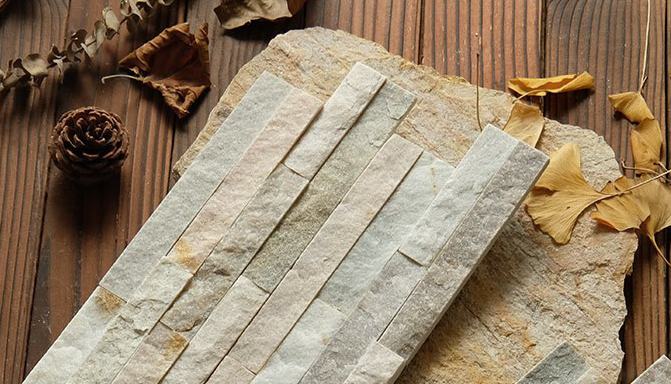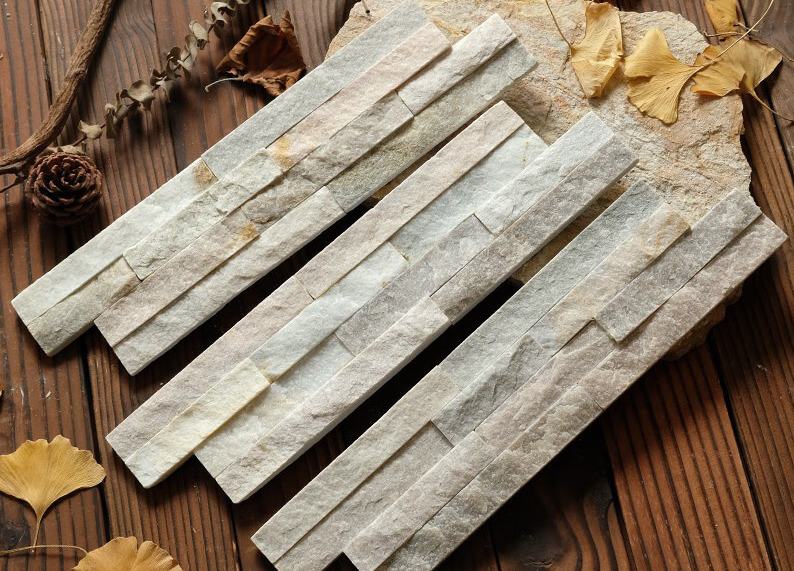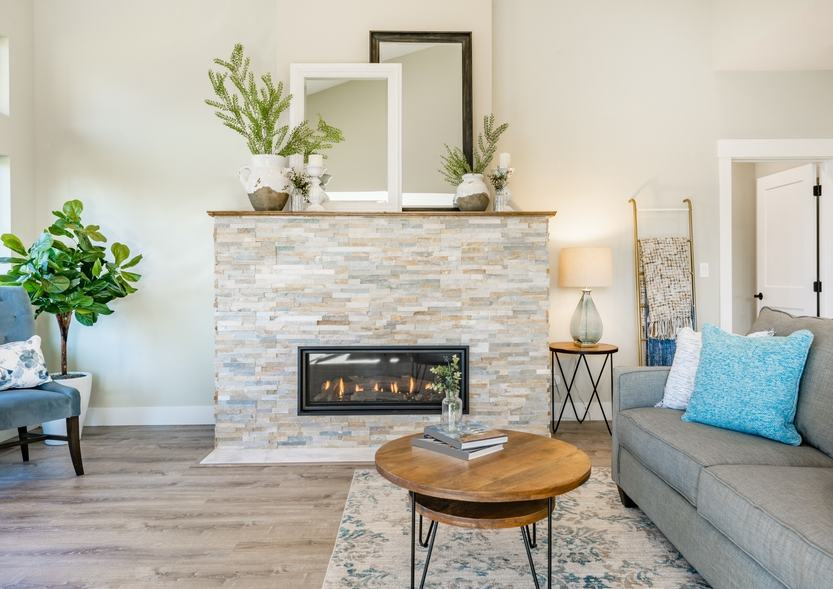A ledger stone fireplace can define a space, but many projects lose momentum when design ambition outpaces installation planning. This guide delivers practical strategies to align visual impact with proven construction methods, showing how contemporary and rustic styles suit different markets, how specific color and texture selections influence ROI, and the installation and maintenance practices that preserve structural integrity and appearance for years.
Ledger Stone Fireplace: Modern Elegance Meets Rustic Charm
Ledger stone fireplaces offer procurement managers, suppliers, and designers a high-value solution that blends clean modern lines with rugged, tactile texture. This adaptability enables teams to satisfy diverse client tastes while maintaining efficiencies in installation and upkeep, positioning the material for success in both residential and commercial markets.
Design and Aesthetic Versatility of Ledger Stone Fireplaces
Ledger stone veneers deliver a structured, dimensional surface that conveys visual refinement and tangible depth. In modern settings, a mortarless dry-stack format creates precise horizontal lines that keep spaces uncluttered. For rustic designs, irregular natural profiles add organic variation and shadowing, reinforcing a traditional feel. Integrating piedra contable with wood beams, matte metals, or minimalist décor allows rapid customization across urban apartments and country lodges without revisiting base design plans.
Functional Benefits and Practical Considerations
Exceptional durability and heat resistance make piedra contable a dependable choice for high-use fireplaces, minimizing replacements and repairs to protect long-term margins. Pre-cut systems such as Kwik Stack provide precise edges for straightforward alignment, while EZ Ledge delivers a rugged aesthetic with installation efficiency. Shorter install times reduce labor costs, enabling contractors to meet deadlines and procurement teams to submit more competitive bids.
Target Audiences and Market Applications
Homeowners seeking distinctive focal points invest in ledger stone to elevate their interiors, while designers appreciate its flexibility for blending contemporary restraint with rustic character in high-traffic areas. Property flippers use ledger stone to enhance perceived value and accelerate sales. For B2B stakeholders, these applications drive faster turnover, improved ROI, and stronger performance on both material and labor investments.

Ledger Stone vs. Other Veneer Options: Design & Performance Comparison
For fireplaces and architectural projects, B2B decision‑makers should weigh both aesthetic impact and performance under real‑world conditions. The table below distills the primary differentiators between ledger stone and competing veneer types, enabling teams to match material selection with project demands, budget parameters, and lifecycle value.
| Criteria | Key Considerations |
|---|---|
| Design Characteristics | Ledger stone delivers a rugged, three‑dimensional profile with authentic color variation, adapting well to both rustic and modern designs. Stacked stone offers precise, clean lines ideal for contemporary schemes. Cultured stone mimics natural tones but lacks genuine depth. Faux stone is light and quick to handle yet less convincing to the touch. Brick veneer maintains a timeless, traditional aesthetic suited to heritage restorations. |
| Performance and Durability | Ledger stone tolerates extreme heat and retains structural integrity for decades, making it a reliable choice for fireplace surrounds. Stacked stone achieves similar durability with slightly reduced heat resistance. Cultured stone remains stable but color can fade over time. Faux stone is more vulnerable to cracking and weathering. Brick veneer offers robust strength but holds heat less effectively and has a flatter surface profile. |
| Installation Complexity and Cost | Ledger stone demands trained installers; panelized formats accelerate work but add expense. Stacked stone installation carries comparable cost and skill requirements. Cultured stone’s reduced weight and precision‑cast panels cut labor time. Faux stone installs rapidly with minimal expertise, minimizing upfront spend. Brick veneer typically lands mid‑range for both budget and install effort. |
| Suitable Applications and B2B Use Cases | Ledger stone fits premium residential builds and luxury refurbishments where authenticity drives value. Stacked stone works for high‑design commercial interiors. Cultured stone offers a cost‑to‑appearance balance for multi‑unit developments. Faux stone supports short‑term installations or low‑budget features. Brick veneer meets the demands of preservation projects and schemes requiring enduring traditional appeal. |
Design Styles: Contemporary, Rustic, Transitional & Farmhouse Aesthetics
Ledger stone fireplaces shape the perception of any space in both residential and commercial projects. Selecting the right style aligns with client preferences while influencing property value and market positioning. For B2B buyers, understanding each approach enables precise inventory matching to target demographics and improved turnover. These 4 styles span from modern minimalism to traditional warmth, giving you versatile, market-ready solutions for varied design briefs.
Contemporary Style
Contemporary ledger stone fireplaces feature clean lines and minimal ornamentation, highlighting the stone’s natural texture. In urban developments, neutral palettes such as black, white, and gray integrate seamlessly with glass, steel, and high-gloss finishes. Geometric patterns like herringbone or chevron add subtle movement while keeping a minimalist aesthetic. Pairing with concrete or slim metal mantels reduces visual weight, making the fireplace an integrated architectural element that complements open floor plans and appeals to clients seeking understated elegance.
Rustic Style
Rustic designs showcase the raw beauty of naturally split stone, pairing rough-hewn textures with reclaimed wood mantels for authentic character. Earth tones such as brown, copper, and beige suit cabins, lodges, and traditional homes, creating a welcoming focal point. Oversized hearths and antique accents add depth, fostering longer stays in hospitality or family spaces. For B2B sellers, rustic ledgers remain a dependable option in regions favoring classic, cozy aesthetics, ensuring steady demand and style longevity.

Transitional Style
Transitional fireplaces blend traditional craftsmanship with modern finishes, offering flexibility across market segments. Combining stone and wood with painted brick or sleek tile bridges old-world charm and contemporary appeal. Proper proportion keeps the design balanced, ensuring it serves as a harmonious centerpiece rather than an overpowering structure. In property flips or staged sales, transitional styles mitigate risk by attracting a wide buyer range and fitting seamlessly into diverse interior refreshes, making them ideal for mixed demographic portfolios.
Farmhouse Style
Farmhouse aesthetics emphasize simplicity and warmth through shiplap surrounds, barn beam mantels, and distressed brick for a handcrafted feel. Whitewashed finishes maintain freshness, while vintage décor and greenery prevent a staged look. Sliding barn doors around the fireplace add functional charm and anchor the room’s design. From a resale standpoint, farmhouse styles offer enduring appeal, enabling homeowners and B2B suppliers to stay relevant in renovations and new builds without concern over rapid style shifts.
Quality Ledger Stone for Inspired Architectural Design
Explore durable, natural stone panels that blend authentic beauty with versatile style. Designed for efficient installation and lasting appeal, our ledger stone series supports contractors, distributors, and designers in creating stunning indoor and outdoor spaces.

The Stone Guru’s Color & Texture Selection for Maximum Impact
When advising clients or managing ledger stone inventory for fireplace projects, color and texture decisions directly influence fit with the property’s aesthetic, perceived value, and adaptability across residential or commercial environments. Strategic selection prevents buyer remorse, minimizes costly redesigns, and positions your projects for stronger ROI in resale or leasing markets.
Choosing the Right Color Palette for Your Ledger Stone Fireplace
Ledger stone ranges from earthy browns, soft grays, and khaki tones for a grounded look to vibrant rust, copper, gold, and touches of blue or green for dramatic impact. Match dominant tones for harmony or contrast intentionally to create a focal point. In high-end developments, a well-targeted palette elevates market appeal and supports premium pricing. For commercial spaces such as hotel lobbies or office receptions, distinctive accents can reinforce brand identity and enhance guest perception. Always test samples under actual on-site lighting, as color shifts markedly between warm indoor illumination and natural daylight.
The Role of Texture in Enhancing Fireplace Design
Texture defines character. Split-face finishes deliver rugged charm for mountain or country properties, honed surfaces bring sleek sophistication to minimalist spaces, and 3D or classic panels add depth and dynamic light play. The right texture ensures the fireplace complements architectural style and delivers the intended emotional impact. In B2B contexts, texture shapes perceptions of craftsmanship and value—dimensional installations often justify higher pricing for materials and finished projects while creating a sensory connection for the end user.
Stone Types and Their Impact on Appearance and Performance
Selecting between slate, quartzite, sandstone, and marble affects both design and function. Slate offers durability and slip resistance for high-traffic commercial areas; quartzite combines strength with subtle sparkle for upscale markets; sandstone provides warmth but may need extra sealing in humid conditions; marble signals luxury and refinement, often used as an upgrade in premium developments. Align stone choice with installation environment—outdoor projects require lower porosity and weather resistance, while indoor showpieces may prioritize tonal richness and refined finish.

Customization in Shape and Arrangement to Fit Your Space
Shape and layout can elevate a standard fireplace into a signature element. Irregular, organic forms suit rustic lodges or boutique resorts, while precision-cut, uniform panels align with contemporary architecture. Mixing shapes and colors unlocks creative flexibility for tailored aesthetics. For mixed-use projects, customization enables design adaptation across lounges, residential units, and storefronts while maintaining a single supplier—streamlining procurement and ensuring consistent quality.
Key Considerations for B2B Buyers in Color and Texture Selection
Treat color and texture as levers for differentiation, shaping buyer sentiment and asset value. Align them with existing architectural elements to avoid conflict, particularly in renovations with legacy design constraints. Procurement teams should prioritize options that offer installation flexibility across varied project scales while maintaining consistent quality. Well-chosen combinations shorten sales cycles, boost satisfaction, and deliver sustained commercial advantage.
Installation Essentials: Substrate, Flashing, Heat Zones & Grout
Ledger stone fireplaces demand precise planning — material selection and technique directly dictate long-term performance, safety, and appearance. With natural stone panels, the correct substrate, flashing detail, heat-zone strategy, and grout specification prevent costly failures and callbacks. The following guidance draws from proven field practice to help contractors, designers, and property owners deliver durable, compliant, and visually consistent results.
Choosing the Right Substrate
Confirm the surface is solid, clean, and fully dry; deficiencies here will compromise adhesion. For indoor or outdoor fireplaces, cement backer board is the preferred substrate for its moisture resistance and structural support. Applying stone to drywall invites moisture damage and heat degradation, leading to detachment or discoloration. Investing in proper preparation eliminates costly substrate remediation later.
Importance of Proper Flashing
Water intrusion can ruin an otherwise flawless installation. Install flashing at all transitions and penetrations — where stone meets the opening, exterior walls, or rooflines — to direct moisture away from the structure. Flashing above and around the fireplace opening ensures runoff is channeled safely. Skipping this step in wet climates guarantees premature repairs or full replacement.
Managing Fireplace Heat Zones
Areas adjacent to the firebox face sustained high heat. Specify mortars or bonding agents rated for high-temperature applications to maintain bond integrity over time. Using products not designed for heat zones risks panel failure and safety hazards, especially in high-traffic or public environments where liability exposure is significant.
Selecting and Sealing Grout
Ledger stone joints often accommodate sanded grout to control shrinkage and cracking. In heat- or moisture-exposed locations, choose grout formulations that resist thermal movement and water absorption. Once cured, seal to block stains and moisture — a low-cost step that extends appearance life in kitchens, outdoor areas, and other spill-prone spaces, reducing maintenance cycles and preserving a professional finish.

DIY vs. Professional: Deciding When to Hire and When to Go Solo
Assessing cost control, technical capability, and project scope is essential when choosing between self-installation of a ledger stone fireplace and engaging a qualified contractor. The table below distills the critical factors procurement leads, project managers, and brand owners should weigh to align budget, risk management, and long-term asset value.
| Criteria | Key Considerations |
|---|---|
| Cost Considerations | DIY avoids labor fees and prioritizes material spend, but errors can trigger budget overruns. Professional installation demands higher total investment yet secures warranties that protect against defects and costly rework. |
| Skill Level and Tools Required | DIY demands proficiency in intermediate carpentry and tile work plus access to precision tools such as a wet saw and level. Contractors bring specialized equipment and proven techniques that ensure alignment and finish meet stringent safety and design standards. |
| Project Complexity and Design Challenges | Simpler runs with pre-assembled panels are manageable in-house. Complex layouts, custom corners, and structural changes require expert oversight to prevent expensive errors and delays. |
| Time Commitment and Quality Outcomes | DIY timelines can extend over several days, with quality dependent on individual precision. Professionals accelerate delivery using efficient workflows, producing uniform joints and consistent leveling that increase asset value. |
| Warranty, Liability, and Maintenance | DIY assumes full risk without formal warranties or liability coverage. Professionals provide contractual protection, liability assurance, and maintenance guidance to maximize performance life. |
| When to Choose DIY Installation | Suited for limited budgets, straightforward designs with ready panels, and owners confident in intermediate skills who can manage tools and precise measurements. |
| When to Hire a Professional | Optimal for complex designs, expansive projects, compressed timelines, or when warranty-backed assurance and proven quality are non-negotiable. |
Maintenance: Sealing, Cleaning & Long-Term Stone Care
Ledger stone fireplaces require more than a quick dust to stay in top condition. For contractors and property managers, a preventive maintenance plan preserves aesthetics and functional value, reducing downtime and costly repairs. Use techniques and products tailored to stone’s properties to extend service life and make upkeep predictable and efficient.
Cleaning Techniques for Ledger Stone Fireplaces
Use tools that won’t scratch or dislodge grains—soft-bristled brushes and microfiber cloths remove dust and soot without driving grit into the surface. Choose a pH-neutral cleaner formulated for natural or engineered stone to prevent etching or weakening grout. Avoid acids, vinegar, or abrasive pads entirely, as they can damage finishes rapidly. Match cleaning frequency to finish type: smooth, honed panels need regular light passes, while textured profiles require focused cleaning to reach deeper grooves, preserving both surface integrity and detail.
Sealing for Long-Term Protection
Apply a breathable penetrating sealer to block moisture and stains while allowing vapor to escape. Skip topical, film-forming sealers that can blister or peel under heat. Reseal every 12–24 months based on location and stone porosity, using shorter cycles for high-traffic or heavily used fireplaces. Effective sealing simplifies future cleaning, prevents soot or organic matter from embedding, and helps maintain consistent appearance—lowering callbacks on commercial installations.
Ongoing Inspection and Maintenance
Conduct an annual inspection to identify early signs of wear such as hairline cracks, loose panels, or heat-related discoloration, particularly where thermal expansion meets moisture ingress. Address minor repairs promptly to avoid costly full panel replacements. Keep flues clear and dampers functioning to limit soot deposits and uneven heating—simple operational checks that protect both performance and appearance for years of reliable service.

FAQs About Ledger Stone Fireplaces
These FAQs address the key concerns B2B buyers, designers, and contractors encounter when planning, installing, or maintaining a ledger stone fireplace. Each response is grounded in field experience to help you control costs, uphold safety standards, deliver design impact, and streamline long-term maintenance.
How much does a ledger stone fireplace cost?
Costs depend on stone type, panel size, and installation complexity. Interlocking panels reduce labor hours compared to full-thickness stone, but factor in professional labor, sealing, and potential structural support. In B2B projects, locking down these variables early protects margins and minimizes change orders. Premium stones like marble increase material costs, whereas straightforward designs over stable substrates can cut labor expenses significantly.
Can ledger stone handle fireplace heat exposure?
Natural ledger stone is non-combustible and heat resistant. When installed to code, it remains stable and safe around fireplaces. For commercial or high-value residential builds, pair the right stone with a suitable substrate to ensure performance under repeated heat cycles. This approach lowers maintenance costs and protects the finish over time.
Is a ledger stone fireplace DIY-installable?
Interlocking panels simplify installs compared to traditional masonry. Skilled DIYers with proper tools can often manage simple layouts. Complex designs, uneven substrates, or high-profile spaces should be handled by experienced installers. In B2B environments, outsourcing ensures timelines are met, warranties honored, and specifications executed precisely.
What’s the best grout color for ledger stone?
Grout color directly influences the overall impact—matching tones deliver a unified, monolithic surface, while contrasting shades highlight each stone’s texture. Neutrals like gray, beige, and earth tones complement most palettes. Select grout to match the stone and mood: blend for subtle elegance or contrast for bold texture. In showrooms and hospitality spaces, align the choice with brand aesthetics to influence customer perception.
How do I maintain a ledger stone fireplace?
Clean regularly with a soft brush and water to prevent dust buildup. For stains, use pH-neutral stone cleaners and avoid acidic or abrasive products. Apply a high-quality stone sealant to protect against spills and simplify cleaning. Schedule periodic inspections for loose panels or failing grout; in B2B facilities, make this part of routine maintenance to protect asset value and prevent costly repairs.
Final Thoughts on Ledger Stone Fireplaces
A ledger stone fireplace combines strong visual impact with reliable performance, making it a strategic choice where design and durability must align. Balancing rustic texture with streamlined lines enables it to suit diverse interiors, while correct substrate preparation, flashing, and heat-rated materials secure long-term value. For homeowners, designers, and investors, selecting the right color and texture, overseeing skilled installation, and maintaining the stone through sealing and careful cleaning will protect both style objectives and resale potential for years to come.

